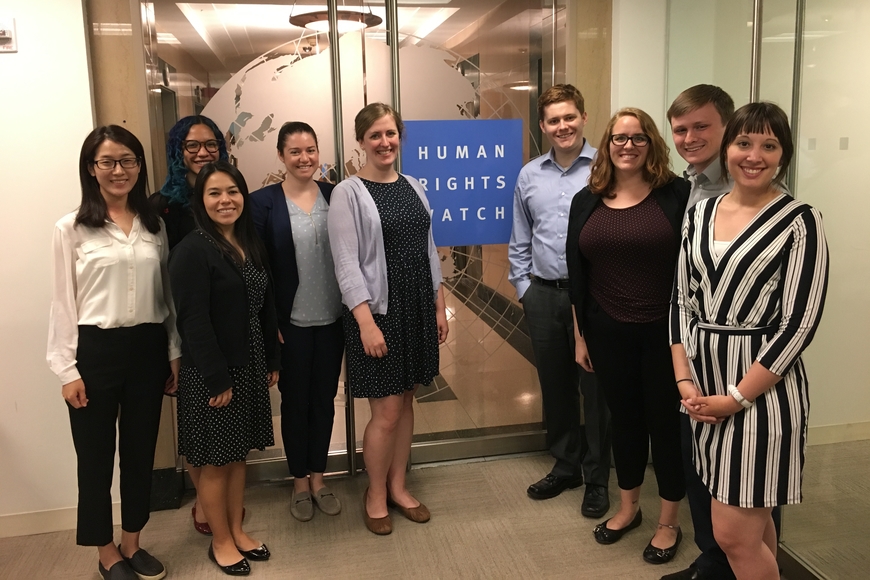How Americans Understand Human Rights in a Populist Moment
Although it followed the growing trend of right leaning populist candidates being elected to office, Donald Trump’s election in November 2016 still surprised some in the United States and across the world. Many in the U.S. have wondered what this populist moment means for U.S. politics, politicians, and policy changes. University of Minnesota Political Science Professor Howard Lavine decided to tackle this question through research in the hope of understanding how human rights organizations and advocates in particular can respond to growing populism effectively in their communications.
Professor Lavine’s project, “Re-Tooling US Based Human Rights Work for the Populist Era” began work in 2018 through the support of a Human Rights Initiative research grant. He and his research team quickly found that they were not the only ones asking themselves how the human rights field should respond to populist rhetoric. International human rights advocacy organization Human Rights Watch and Minnesota-based non-profit The Center for Victims of Torture became key collaborators on the project early on providing financial and technical support. Additionally, a group of 13 graduate students from the Humphrey School, College of Liberal Arts, and Law School contributed to the project early on by completing a literature review on U.S. public opinion on human rights issues that they presented to HRW headquarters in Spring 2018.
Professor Lavine and his team, in collaboration with HRW and CVT, narrowed their inquiry to 6 human rights topics, and then designed experiments around the topics: immigration, refugees, torture, civilian casualties by drone strikes, foreign aid to authoritarian regime, and excessive police violence. Professor Lavine, along with a graduate student research assistant, input from HRW, and Shannon Golden of CVT then developed survey questions about each topic in order to measure American public opinion about them.
However, it was not as simple as developing basic questions. Professor Lavine and his team crafted a number of different questions for each topic using a variety of “cues” and “frames.” Professor Lavine explains that in political science parlance, a cue is related to who is doing the messaging (such as a human rights organization or a particular politician) and a frame is the way in which the issue is presented. For example, a question about civilian casualties from drone strikes may frame the issue in terms of the loss of human life or in terms of violating international norms or law. In sum, the team used three cues and three frames for each topic leading to 72 possible questions to include in a survey. Each question was developed meticulously and debated at length by the research team before being added to the survey.
Once the survey questions were developed, the team tested the responses of survey participants to see how different frames or cues impacted the support or lack thereof for the different human rights topics. They were especially interested in whether certain frames or cues, or a combination of them, could move a person’s opinion on the topic in a significant way. The different surveys were administered to samples of people who represented the American public at large, and also to samples of people that included an overrepresentation of Trump-supporting Americans.
While the team is still in the process of evaluating their results and drawing conclusions, Professor Lavine does have some preliminary findings he considers useful. For example, the results indicate that overall it is possible to move people’s opinions towards more pro-human rights on four of the six human rights topics: torture, immigration, aid to authoritarian regimes, and refugees. However, regardless of cues or frames, it was much more difficult to change opinions on excessive police violence or civilian casualties by drone strikes.
Professor Lavine also highlights that particular frames or cues were more influential than others in moving opinion of any respondent. For example, HRW was particularly curious how influential a “local norms” frame would be in shifting opinion on human rights. In other words, they wanted to know whether people cared that their community felt positively about human rights and if that could influence their personal opinion. Professor Lavine says the results suggest that this frame worked to change public opinion about one-fifth of the time among all respondents. Among Trump-supporters though, it was much more influential. Trump-supporters were also more strongly influenced by messages that came from military leaders or experts. Other frames such as “spelling out the abuse on the victims” or “appealing to national sensibilities and U.S. law” were especially effective in influencing pro-human rights opinion in general.
Although these initial findings can easily be used to draw sweeping conclusions about public opinion and human rights in the U.S., Professor Lavine cautions that these results are just the first step in understanding U.S. public opinion on human rights topics. So far, the team generally agrees that the results suggest that in many cases, “putting a frame and a cue together are typically better than just one or the other alone” when seeking to influence public opinion. Beyond that though, Professor Lavine wants to remind readers of the study that the results suggest “average treatment effects. Not every person responds in the same way.”
Although the team is still analyzing the data, there are a number of exciting products that are expected to result from this project. Professor Lavine expects much of the research to make up a few chapters in a forthcoming book of his. Publishers such as OpenGlobalRights and the The Washington Post’s The Monkey Cage blog have expressed interest in publishing articles on their work. The team also has plans to visit HRW, CVT, and Refugees International this summer to present their findings.




